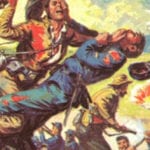 Politics
Politics  Politics
Politics  Weird Stuff
Weird Stuff 10 Eggs-traordinarily Odd Eggs
 History
History 10 Desperate Last Stands That Ended in Victory
 Animals
Animals Ten Times It Rained Animals (Yes, Animals)
 Mysteries
Mysteries 10 Devastating Missing Child Cases That Remain Unsolved
 Creepy
Creepy 10 Scary Tales from the Middle Ages That’ll Keep You up at Night
 Humans
Humans 10 One-of-a-kind People the World Said Goodbye to in July 2024
 Movies and TV
Movies and TV 10 Holiday Movies Released at Odd Times of the Year
 Politics
Politics 10 Countries Where Religion and Politics Are Inseparable
 Weird Stuff
Weird Stuff 10 Freaky Times When Famous Body Parts Were Stolen
 Politics
Politics The 10 Most Bizarre Presidential Elections in Human History
 Weird Stuff
Weird Stuff 10 Eggs-traordinarily Odd Eggs
 History
History 10 Desperate Last Stands That Ended in Victory
Who's Behind Listverse?

Jamie Frater
Head Editor
Jamie founded Listverse due to an insatiable desire to share fascinating, obscure, and bizarre facts. He has been a guest speaker on numerous national radio and television stations and is a five time published author.
More About Us Animals
Animals Ten Times It Rained Animals (Yes, Animals)
 Mysteries
Mysteries 10 Devastating Missing Child Cases That Remain Unsolved
 Creepy
Creepy 10 Scary Tales from the Middle Ages That’ll Keep You up at Night
 Humans
Humans 10 One-of-a-kind People the World Said Goodbye to in July 2024
 Movies and TV
Movies and TV 10 Holiday Movies Released at Odd Times of the Year
 Politics
Politics 10 Countries Where Religion and Politics Are Inseparable
 Weird Stuff
Weird Stuff 10 Freaky Times When Famous Body Parts Were Stolen
Top 10 Poorly Planned Battles
In Ken Burns’ nine-part World War 2 documentary, the aptly named fifth episode, “FUBAR,” describes the powerlessness of Allied soldiers fighting Germany and Japan. “On both sides of the world,” the narrator says, “a generation of young men will learn a lesson as old as war itself — that generals make plans, plans go wrong and soldiers die.”
In World War 1, the Brits coined a more colorful phrase to describe the lethal mix of brave soldiers and poor generalship: “Lions led by donkeys.” Luckily, the vast majority of military leaders in those crucial conflicts were far more capable than the following ten examples.
10 Oddities That Interrupted Military Battles
10 Battle of Fredericksburg (American Civil War)
Spoiler alert: This list’s #2 is so ranked because it was preceded by the Battle of Fredericksburg. Why? Because Fredericksburg’s victors saw the deadly result of a large force charging an extended distance at an entrenched position… yet still attempted it just seven months later.
Before they found Ulysses Grant, the Union Army was badly outgeneraled in the Civil War. One also-ran was Ambrose Burnside – he of the bushy-eared hairstyle now known as sideburns. The Battle of Fredericksburg (Virginia) commenced December 11, with two days of the Union Army gaining a foothold on the same side of the Rappahannock River as Confederate generals Robert E. Lee, Stonewell Jackson and James Longstreet.
The action’s epicenter was Marye’s Heights, a hilly slope rising 50 feet above the plain. At the peak, rebels dug in behind a stone wall. Even now, surveying the ground leaves visitors wondering what the hell Burnside was thinking when he sent wave after fruitless, bloody wave up the slope. By mid-afternoon subordinates, including the audacious “Fighting Joe” Hooker, pleaded with Burnside to relent.
Instead, Burnside doubled down. The result was a turkey shoot: Confederate artillery had the landscape completely covered by artillery. No one got closer than 40 yards from the wall. Nearly 1,300 dead and 10,000 wounded later, Union casualties doubled their counterparts. Despite claims he was poorly served by his generals, Burnside was in charge and the buck – and the suicidal charges – stops with him.
9 Battle of Agincourt (Hundred Years War)
For a commanding officer, few mistakes are less forgivable than letting an easy, even bloodless victory slip away – in this case, literally.
In late October 1415, after failed negotiations ended a lull in the protracted Hundred Years War, an English army under King Henry V was marching across northern France. Things weren’t going well, with supplies running short and an atypically high number of deaths due to disease. Leaders decided to retreat to English-held Calais on France’s west coast; unfortunately, they soon encountered an army of 15,000 Frenchmen – roughly double the English total – blocking their escape.
French commander Constable Charles d’Albret had a layup: all he had to do was stop, camp and either siege the English into surrender or force them to charge a line double their strength. But when the English began aggressively advancing with flags flying and soldiers taunting, d’Albret decided this perceived disrespect could not go unpunished.
So he sent thousands of men across a narrow field of sticky clay mud, turned to a mucky quagmire by heavy rain. The soldiers slipped, slid, got up, fell again. English archers had a field day; the French were softened up for wholesale hand-to-hand slaughter. Around 6,000 Frenchmen, including d’Albret, were killed, with about 2,000 more taken prisoner. The English lost approximately 400 men for a casualty ratio of an astounding 20 to 1.
8 Battle of Tora Bora (NATO-Afghan War)
In the aftermath of the September 11, 2001 terrorist attacks, the US and its NATO allies invaded Afghanistan with two goals. The first, routing the ruling Taliban regime, was quickly accomplished via overwhelming force. The second, capturing or killing al-Qaeda mastermind Osama bin Laden, would require more stealth. With sympathizers dotting the desolate landscape, catching bin Laden by surprise would be no small feat.
On December 3, 2001, a group of 20 U.S. CIA National Clandestine Service forces landed in the mountainous Tora Bora region. Afghan’s US-friendly Northern Alliance had alerted NATO of an al-Qaeda base there – and of bin Laden’s rumored presence. Together with another 70 US special forces and backed by airstrikes, they made steady advancements, clearing caves and capturing enemies as they went.
Then they inexplicably negotiated a truce. Officially, al-Qaeda fighters were organizing their surrender; unofficially, bin Laden was escaping. A key factor was that the US, having failed to swiftly deploy more troops, had delegated the task of guarding escape routes to untrained, disincentivized allies with inferior equipment – akin to a narcoleptic security guard protecting a vault.
Several days passed, the fighting resumed and the battle was eventually won – but the one-man prize had fled to Pakistan, and would elude justice for another decade. The failure to fully commit more troops sooner – and the farcical, time-buying truce – turned a quick victory into what became the longest war in American history.
7 Battle of Lake Trasimene (Second Punic War)
Hey Romans: Scout much? Assessing the strength of one’s enemy has been Military 101 for millennia. Without reconnaissance, an army is groping blindly.
At the outset of the Second Punic War, in 217 BC the Carthaginian commander Hannibal led an army of 50,000 through northern Italy. For a time, he eluded the pursuit of Roman commander Gaius Flaminius Nepos. But on June 24, an advanced band of Roman troops caught up with Hannibal’s rear guard near Lake Trasimene.
It was a trap. The Carthaginians were waiting to ambush the Romans, who they knew had far fewer soldiers. But instead of dispatching a few mounted men to survey the landscape and the enemy’s strength, Flaminius ordered his entire army to race blindly into battle.
Forgoing recon was inexcusable. Flaminius knew where the enemy was, so pausing to understand their configuration ran no risk or them escaping his reach. And even if they were somewhat scattered – for example, in a convoy formation – did Flaminius really think Hannibal had traversed all this way only to divide his large army on foreign soil? He had to know he’d be dealing with the full Carthaginian army, likely far more than the 30,000 men Rome had on the scene.
The result was a massacre. Flaminius was killed and, of his 30,000 men, half were either killed in battle or drowned attempting to swim to safety. Another 10,000 were captured. Carthage lost only 2,500 men.
6 Battle of Brooklyn (American Revolution)
Before the Battle of Brooklyn witnessed one of warfare’s most fortuitous coincidences, it became the stupidest decision George Washington ever made.
Let’s start with the ending: In August 1776, with his back to New York’s East River and his 9,000-strong Army facing certain ruin, Washington ordered his men “to impress every kind of watercraft… and have them all in the east harbor of the city by dark.”
The British, thinking they had ample time for what likely would have been the war’s decisive battle, delayed attack to wait out an unseasonable fog. That night, Washington’s troops silently floated to the safety of Manhattan. The British awoke to capture an army that had vanished into thick air.
All weather-related miracles aside, the obvious question: “Why did Washington need a miracle to avoid complete disaster?” Simply put, he got caught completely by surprise, which isn’t good when you’re fighting a) against a superior force and b) surrounded by water.
With Boston’s Bunker Hill as precedent, Washington expected an assault from sea; instead, British forces discretely came ashore miles away and marched overnight to reach the Continental Army’s rear. It took 400 brave Marylanders slowing the enemy with suicidal charges for the bulk of Washington’s men to escape immediate capture. Even so, they were hemmed in against a deep, wide river. Without the fog that followed, there’d be no Founding Father.
5 Battle of Hattin (Crusades)
Dignity and warfare often don’t mix. Just ask King Guy of Jerusalem.
In 1187, Muslim leader Saladin was looking for a decisive blow to settle the Ayyubid-Crusader War. Assembling the largest army he’d ever commanded, some 40,000 men, he laid siege to the Crusader fortress of Tiberias in modern-day Israel.
Meanwhile, King Guy of Jerusalem – after reconciling with a rival from Tripoli, Raymond III, who the Muslims believed could be installed as a proxy ruler – mustered a force of nearly 20,000. Given the side’s inferior numbers, many of Guy’s subordinates recommended hitting the invaders where it hurt: their supply lines. In particular, it was early July and water was precious in the arid region.
Choosing chivalry over common sense, Guy scorned the advice as cowardly and beneath his royal dignity. Instead, he marched his men across the desert directly toward Tiberias. Saladin, apparently unimpressed with Guy’s dignity, responded by using his superior numbers to block access to fresh water. He then set fire to the dry flora, adding insult to parched injury with acrid smoke.
Men need water more than dignity – especially in a desert. Guy was forced to change course, heading toward the refreshing springs at Hattin. They never made it. Raymond broke through and escaped, and others deserted. The Muslim army slaughtered most of the Crusaders on the field and captured a shard of the True Cross, reputedly wood from the cross on which Christ was crucified.
4 Battle of Monte Cassino (World War 2)
How do you win a battle yet still end up on this list? By blowing up a 1,400-year-old abbey for no reason, then suffering nearly triple the casualties as your opponent.
In early 1944 the Allies were learning the hard way that what Prime Minister Winston Churchill had called the “soft underbelly of the Axis” – Italy – was anything but tender; in fact, US General Mark Clark would soon call it “one tough gut.” Still, Brits and Americans slowly gained ground as they plodded toward Rome. They approached Monte Cassino, at the western end of the Axis’ Winter Line, defended by the Nazi’s 10th Army.
There, progress stalled in a valley below a 6th Century hilltop abbey. Repeated artillery attacks on Allied troops caused leaders to conclude the Germans had occupied the hallowed ancient complex.
They were almost certainly wrong.
On February 15, Allied bombers dropped 1,400 tons of bombs of the abbey… after which German paratroopers promptly occupied the rubble – for real this time – and established even stronger defensive positions. Shooting downward from a ready-made fort on exposed raiders, 140,000 German soldiers stood firm against twice as many men. It took four horrifically bloody assaults over the next three months for the ruins to be taken by a Polish corps operating under British command. The Allies suffered over 55,000 casualties, the Axis approximately 20,000.
3 Battle of Karánsebes (Austro-Turkish War)
The only reason this entry is a stretch is because, one would think, a battle should involve both sides of a war.
In September 1788, the 100,000-strong Austrian army was making camp near Karánsebes in modern-day Romania. Some cavalrymen crossed the Timis River at night to scout for the opposing Ottoman forces. Instead of hostile Turks, they found locals peddling booze. Infantrymen crossed to partake, but the inebriated horsemen refused. A fight followed – and then a shot.
Other infantrymen showed up, shouting “Turks!” In the confusion, BOTH sides fled believing the Ottomans had ambushed them. Making matters worse, German-speaking officers, attempting to restore order, shouted, “Halt! Halt!” which many non-German-speaking soldiers (including Italians and Croats) misheard as “Allah! Allah!”
Then bad leadership drastically escalated matters. As the cavalrymen fled back to camp, a General named Colloredo thought that, for some reason, a small band of Ottoman cavalry were charging a gigantic enemy encampment in the middle of the night. Regardless how extremely unlikely (and suicidally stupid) that prospect was, he ordered artillery to fire, waking the entire camp… which promptly scattered and fled in fear, shooting at shadows of supposed Turks as they ran. Incredibly, the entire army retreated from the imaginary enemy.
The nonsensical event was as lethal as it was dumb: TEN THOUSAND soldiers were killed or wounded. Two days later, the Ottoman army – the real one – arrived, stepped over dead and wounded Austrian soldiers and easily took Karánsebes. What’s German for “morons?”
2 Pickett’s Charge (Battle of Gettysburg – American Civil War)
Ironically, among the poorest-planned and most costly battles in American history was devised by arguably the most brilliant military genius the country has ever produced: Robert E. Lee.
1863’s Battle of Gettysburg was a multi-day conflict in which the Confederacy had, for the second time, invaded the north. By July 3, Gettyburg’s third day, ample blood had been shed without much ground gained. Both sides were dug in along a series of ridges and hilltops, with Union troops largely playing defense – an especially advantageous position given the era’s weapons and tactics.
According to historian Shelby Foote, Lee “had has blood up.” He’d tried the right and left flanks; now he commanded an all-out assault on the center, which involved hurling thousands of men across an open field against an entrenched line nearly a mile away. Several subordinates begged him to reconsider, deeming it suicidal. Eager for glory, Major General George Pickett wasn’t among them.
Led by Pickett and other generals, nearly a dozen brigades comprising 12,500 troops began marching toward the distant Union lines, fortified with cannon behind a stone wall. Only a handful made it over the wall – an indented parcel now called the Bloody Angle – and were quickly cut down or captured. Over 1,100 rebels died, over 4,000 were captured and only a quarter returned unwounded.
“Gettysburg was the price the South paid for having Robert E. Lee as commander,” said Foote, alluding to the bravado that made Lee’s legend.
1 Little Bighorn (US-Indian Wars)
Custer’s Last Stand – or, rather, the recklessness that necessitated such a futile finale – earns its namesake first place on this list of battlefield buffoonery.
Notably, 13 years earlier Custer was at Gettysburg where, a month after becoming the Union Army’s youngest general, he helped turn back Confederate cavalry in an engagement overshadowed by Pickett’s Charge. Still, evidenced by his graduating dead last in his West Point class, Custer was more bravado than brains. And on June 25, 1876, his brainless bravery would get him and his entourage – 267 other US soldiers – senselessly killed.
So complete was the disaster that details of the battle are unverifiable, because no soldier survived to report on it. What is known is that, after dividing his initial force of 600 into several groups, Custer mounted a full-scale frontal attack on more than 2,000 battle-ready Lakota Sioux and Northern Cheyenne warriors.
Custer charged the center of an enemy at least EIGHT TIMES his strength with no escape route. Like a guppy swimming into a shark’s mouth, the Indian flanks collapsed around Custer, and the US soldiers were simply swallowed and slaughtered.
Worse, Custer did this even after noticing what he admitted was a surprisingly large Indian encampment nearby. In fact, this hastened his attack, under the ludicrous logic that, despite being severely outmanned, he had to strike before the town disbanded and escaped in smaller groups. It was the height of military hubris and a disgraceful dereliction of duty.
10 Forgotten Battles That Changed World History








